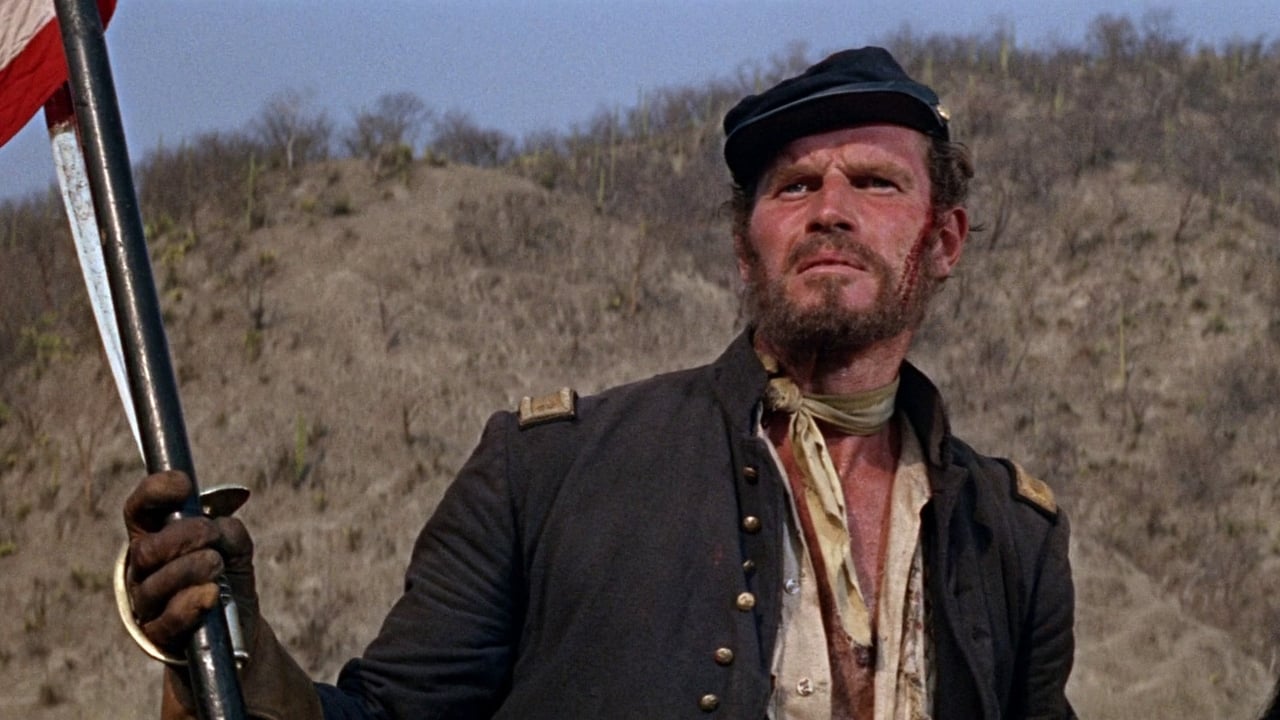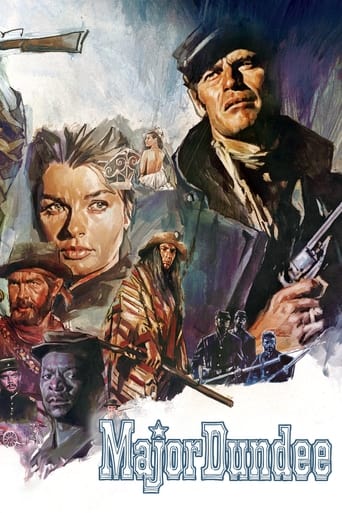Inclubabu
Plot so thin, it passes unnoticed.
Smartorhypo
Highly Overrated But Still Good
Kien Navarro
Exactly the movie you think it is, but not the movie you want it to be.
Walter Sloane
Mostly, the movie is committed to the value of a good time.
ma-cortes
Exciting and enjoyable Western with a very fine cast , luxurious cinematography and gorgeous outdoors from Mexico . This cultured actioner Western contains impressive feats , dashingly violent scenes , rider pursuits , breathtaking Indians attacks and loads of crossfire .Interesting and mythical film follows a misfit group across Mexican territory to chase a renegade Apache called Sierra Charriba who is loosely based on the real-life Apache warrior chief Vittorio . It is set during the last winter of the Civil War, cavalry officer Major Amos Charles Dundee (Charlton Heston) leads a contentious troop of Army regulars along with a band of Confederate prisoners led by Captain Benjamin Tyreen (Richard Harris) who volunteer to go into Mexico and track down a band of rampaging Apache Indians . This is a flawed but watchable Peckinpah including thrills , emotion , shootouts , go riding and a love story between Heston and Senta Berger. An overlong run film , approx. 124 minutes , and being severely cut from its premiere , being directed with typical verve by the great Sam Peckinpah . Rich in texture and including intelligent screenplay full of incredibly lyrics scenes . Taut excitement throughout , beautifully photographed and spectacular bloodletting . Vibrant as well as brilliant all-star-cast displays exceptional performances . Very good acting by main actors , as Heston as tough officer leading assorted misfits against Apaches and Richard Harris as two-fisted rebel Confederate . Although Charlton Heston famously did not get along with Richard Harris, who frequently stayed up drinking into the early hours and was often late on set. During filming, Sam Peckinpah was so obnoxious and abusive towards his actors that Charlton Heston actually threatened the director with a saber ; Heston later remarked that this was the only time he had ever threatened anybody on a movie set . Lavish production by Columbia Pictures that wanted to fire Sam Peckinpah but Charlton Heston convinced it not to, when he threatened to return his $400,000 fee and pull out of the project. Support cast is frankly well , plenty of familiar faces . Many of the actors who came to be known as the "Sam Peckinpah Stock Company" appeared in this film and four years later in Sam Peckinpah's Wild Bunch (1969): Warren Oates, Ben Johnson, L.Q. Jones, Dub Taylor, Aurora Clavel, Enrique Lucero. Atmospheric and evocative musical score by Daniel Amfitheatroph . Glimmer and evocative cinematography in Panavision by excellent director of photography Sam Leavitt , though Peckinpah originally wanted Lucien Ballard, with whom he had had a good working relationship on Ride the high sierra (1962) . The motion picture was spectacularly directed by Peckinpah , though he downed it , being strongly cut by others . After the success of Sam Peckinpah's later Wild Bunch (1969), Columbia Pictures told him they would allow him to re-shoot parts of this film that had been cut from the released version , Peckinpah, naturally, declined the offer .
Tony Keith
I had some hope of finding something to enjoy about this movie, given the star studded cast, but I came away disappointed. Heston's embittered Major was adequate enough, but Richard Harris, the British Actor was completely over the top, hamming it up as the dissident Confederate captive. He must have been included as a sop to the then current "British invasion",that, along with the Beatles, included Lawrence Harvey, Richard Burton, Michael Caine, et al. In any event, he brought "Scene stealing" to a new low.The weak background plot, which has to do with searching out marauding Apaches, is nothing more than a set up for the real showdown between the two protagonists, Heston and Harris.The attempts to give the story grit and realism, was overdone. The one-armed scout, played by James Coburn had me constantly scrutinizing his outfit to figure out how they hid his arm, and the completely gratuitous and stereotypical racial scene between the southern soldier and Brock Peters was farcial, as was the way this same supposedly tough, battle hardened soldier was sent yelping by the old preacher.It might have appeared "edgy" in the 60s, but when soldiers are surrounded by the enemy and in imminent danger of being wiped out, race and background become secondary issues.I didn't stay around for the ending, as I really didn't care what happened to the characters.A John Ford western it was not.
denis888
Well, the very combination of western, Civil War movie, love story, even some tawdry comedy and drama is not always as exciting as it can seem. Major Dundee is a very typical period piece, such a movie could have been done in the 60's only, and in the 60's only such dialogs and prolonged battle scenes could be shot. The movie suffers a lot from a very sketchy narration, obviously badly shot battle scenes, some real poor dialogs and some unnatural sentiments and/or drama moments. The movie is not that all bad, as there are some real gorgeous Texan scenes, some cool moments of jail routine, some very fine plot ideas. The very story is nothing new - revenge, duty call, treachery, blood, war. Well, it is OK, well done in most moments. But not that great as it could be Only for Peckinpah's fans
Steffi_P
The 1960s were surely the weirdest era in Hollywood history. Never was there a sharper division between up-and-coming youngsters and grizzled traditionalists. It was strange enough to see the new and the old side by side on theatre posters or list of award nominees, much stranger still to see the disparate influences mixing together in the one picture. The Western, by now an unfashionable genre in any case, was going through a revisionist anti-establishment phase, but the conventions of this most American of genres were dying hard.At first glance Major Dundee could be something out of the 50s. It's one of the last Westerns in which the Indians are unequivocally the bad guys, and the whole thing is packaged like one of the old classics, with a handsome lead man, an obligatory (but somewhat limp) love angle, blazing Technicolor, and even an upbeat theme song with a rather corny Ned Washington lyric. The flick was penned by TV writer Harry Julian Fink and B-movie hack Oscar Saul, so not the most prestigious duo but consider that this was one of the biggest breaks either ever had. It seems that on some level they are trying to be a bit more revisionist and edgy, most likely with input from director Sam Peckinpah, who had some hand in the screenplay, although I doubt it was a decisive one. The title character is a sort of unfeeling cynic who places military protocol above all else, and the rivalries between his men are beefed up into the real conflict of the story. But this is not quite so provocative as it sounds. Western anti-heroes had been popular for some time now, and Dundee is not that different from Frank S. Nugent creations like Colonel Thursby (Fort Apache, 1948) and Ethan Edwards (The Searchers, 1956).Behind the camera, Peckinpah stands out as a would-be maverick surrounded by a regularly professional crew. In particular the balletic editing patterns he would later be known for are nowhere to be seen. Still, you can see his thoughts are leaning that direction. He makes most shots a unit, a frame for one actor or action, which necessitates a complex editing pattern regardless of the editor's personal take on it. Violence is sudden, chaotic and, like a Michael Curtiz battle sequence, composed of eye-catching little snippets of action. We also see a lot of the judicious god shots – that sense of cool detachment that characterises prime Peckinpah. And, whatever his contribution to the script it seems he aims to bring out the most cynical elements in the story on a visual level. He even portrays the West as a ravaged landscape, barren and spiky, filled with the ruins of Old Mexico – the only relics of medievalism in the New World.Standing tall amongst this landscape is a delightful rogues' gallery of a cast. This is the kind of role that really suits Charlton Heston. A bit like the guy he played in The Big Country, not actually bad but certainly obnoxious, yet still effortlessly attractive and charismatic. He has a body that makes lounging around look almost noble, and a face to which a sardonic glance is handsome. I'd much rather see him like this than faking it as some clean-cut good guy. Richard Harris gives his character a kind of melodramatic sense of self-importance, playing the kind of gentleman-cum-hell-raiser that he was in real life. But what one really remembers is that supporting cast of rugged uglies, with faces that match the wilderness. What's really great about guys like L.Q. Jones, Slim Pickens and Warren Oates is that they look totally authentic, to the point where it's even hard to think of them as actors. You just can't imagine them going back to a caravan to shower off the dust.In the end it is really these little touches – the motley cast, the impressive little proto-Peckinpah moments – that make Major Dundee worth watching. It does suffer from a lack of cohesion, and is certainly held back by that unshakeable studio Western look. Eventually the old time Western style would fade out completely, and we would at last get some pure and decently-made neo-Westerns, of which Peckinpah would be a champion. All the same it's sad to see the remnants of the classic Western looking so awkward and dated here, for they come from the genre's golden age, which no amount of revisionism or even nostalgic homage can hope to match.

